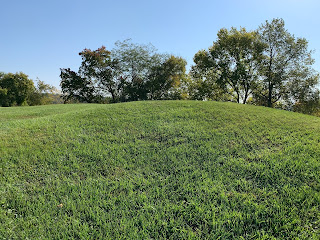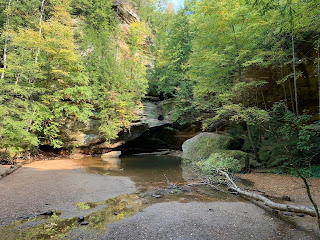I've had a number of backpacking trips cancelled this year due to the ongoing COVID-19 pandemic. Additionally, I tripped, fell, and broke one of my fingers while on my morning run a few days ago. So, when one of the local groups I've been hiking with posted a moonlight overnight trip to Blood Mountain on Halloween Eve, I couldn't help myself from signing up. This particular group tries to strictly define and record their members past experience, which I can completely understand. It gives trip leaders some basis to determine who is capable of the tougher outings, of which this is one. Since I have only a few outings with the club, the trip leader contacted me in advance to ensure I knew what I was getting myself into. I explained that I was a recent transplant to the area and listed off some of my experience out west, which put his mind at ease.
We met, all eight of us, at the Woody Gap Trailhead, which is on the Appalachian Trail (AT) around 8:45 PM. At elevation and with a brisk wind blowing in, it was pretty cold up there, but the brilliant full moon above our heads inspired us and our thirst for adventure kept us warm while we assembled our gear. After a quick round of introductions, we hit the trail promptly at 9:00 PM as scheduled. It seems many of these folks have been on trips together in the past, but they welcomed me with open arms.
The first mile and a half or so up to Preachers Rock is somewhat steep, but bathed in full moonlight the trail was easy to follow. As we got to moving at a pretty good pace, our bodies heated up quickly and it was soon time to strip off some layers. Along the way, a couple of my fellow hikers inquired about the splint on my left hand protecting my broken finger. I think they thought I was a little crazy for doing such a crazy backpacking trip in such a condition, but they kept their thoughts to themselves. In truth, the splint only proved to be a minor inconvenience during the trip. I think the worst part was not be able to put a glove over that hand when we stopped for longer breaks such as to take in the view from Preachers Rock. The cold air had a numbing affect.
The next several miles undulated as we followed this section of the AT over some smaller mountains on our approach to Blood Mountain, which is the highest point along the Georgia section of the long trail. We did see a few tents along the way, but no other hikers. Only crazy people would be out hiking during the midnight hour of a full moon on Halloween . . . or vampires . . .
Arriving at the Blood Mountain Shelter, we removed our packs put on additional layers and sat or layed out on the bare granite to take in the cloudless night sky, of which the full moon was the centerpiece. After laying on the cold stone for a couple of minutes, I decided to pull out my foam sleeping pad, which was easily accessible from my pack and lay on that instead - good call. The combination of comfort, cool air, and the fact that I had now been awake for nearly 24-hours straight began to weigh on me and I could feel myself starting to slip into slumber. Luckily, we didn't stay long and soon headed back down the mountain to our planned campsite, the Woods Hole Shelter.
Now feeling much like a zombie as the clock nears the 3:00 AM hour, we trudge a half-mile off trail only to find the shelter full of other campers. After a quick discussion, we make the group decision to return to the fork in the trail and camp there at a decent spot we saw earlier. The only real concern is food storage in this bear-populous area. I packed my bear can and so, I felt okay about. After we got our tents set up, I offered up the additional space in my can for others to use, which they thank me for and took advantage of. For just an overnight trip, I didn't pack a lot of food and was happy to share the ample storage remaining in my bear can.
While I told everyone good night and quickly traveled off to dreamland, some of my fellow hikers decided to get a fire going and have a few beers, which they had packed with them. I would have loved to joined them, but now after 4:00 AM, but body was having none of it. I crawled into my sleeping bag and was out like a light.
Soon afterwards, we break down our tents, load our packs, and start the trek back to our cars at Woody Gap. I don't remember this being quite so steep last night, but with the dark and my groggy state, maybe I just didn't notice. The group spreads out over a pretty good distance, but our group leaders are good about waiting for everyone to occasionally catch up.
Finally arriving back at the trailhead, I thank my fellow adventurers for an excellent time. We hiked 11.3 miles last night and another 7.5 this morning, for an 18.8 mile total trip distance. They all wish me well and we look forward to meeting again on the next trek. As for me, I've got an hour-an-a-half drive between me, my shower and my bed.


















































